COVID-19 | PREPARE FOR A WHOLE NEW WORLD OF FOODSERVICES POST COVID-19
A whole new world of foodservices according to the TAF Catering Consultancy
This is an article about contract catering. More specifically, this is an article about the future of foodservices in the UK in 2020 and beyond. Moreover, this is an article promoting the 7 Ps – Proper Planning & Preparation Prevents Particularly Poor Performance*1.
It’s about planning, developing and delivering a sustainable and robust approach to what will undoubtedly be a different tomorrow’s world of contract catering (post COVID-19).
“Give me six hours to chop down a tree and I will spend the first four sharpening the axe.” | Abraham Lincoln
It’s my wish to support you, the reader, to ‘sharpen your proverbial axe’ to develop an effective master plan of action and a set of tactics to achieve one long-term or overall aim: to develop a coherent economic strategy so your foodservices succeed in a whole new world, as the economy picks up (post COVID-19) and humans start having confidence to eat in the workplace again. A word of warning: do not be under illusion that future foodservices will be what they were before.
We’re basing our catering consultancy advice on data and perspective-driven insight. We want you to cross over into the realm of thought leadership today; your business may depend on your ability to do so which, in turn, affects whether there’s an industry for us to consult in!
With the above said, this article is for anyone in foodservices, contract catering, restaurants, facilities, or maybe you’re an organisation with an in-house staff restaurant and responsibility to cater for each and every one of your employees, workforce members or your student populations every day.
Planning now for when the current crisis is over is both crucial and critical, so when the time comes you are ready. Think of today as … the day you have that bonus ball, that extra 10th life, that ace up your sleeve. If you use today wisely, whilst the UK economy is (in effect) on paid suspension, you’ll not only bounce back but thrive in the new world of foodservices with furious energy.
 So, who am I to provide this sound advice and where have I come from to give it? I’m Tracey Fairclough, a catering consultant first. Previous to catering consultancy, I worked for a large caterer and then a small one (as Commercial Director) for over a decade; 15 years of my life devoted to food and service. Previously, I was in marketing and advertising for 16 years, working for the most successful advertising agencies on the planet; my life was focused on sales and selling. Previous to that I started a Law Degree and finished with a Business Degree, following A Level Economics; I studied growth strategies. Starting from the economics is a good place to start.
So, who am I to provide this sound advice and where have I come from to give it? I’m Tracey Fairclough, a catering consultant first. Previous to catering consultancy, I worked for a large caterer and then a small one (as Commercial Director) for over a decade; 15 years of my life devoted to food and service. Previously, I was in marketing and advertising for 16 years, working for the most successful advertising agencies on the planet; my life was focused on sales and selling. Previous to that I started a Law Degree and finished with a Business Degree, following A Level Economics; I studied growth strategies. Starting from the economics is a good place to start.
SECTION 1 | A NEW HOPE
PART A | The Economic Status: 7 Things We Know Already
- February saw our financial markets bolt with the threat of a covid-19 pandemic. March saw policymakers leap into action early doors. Rishi Sunak – within weeks of promotion to Chancellor of the Exchequer – was one such jumper, with one single vision: to protect the UK economy.
- With this said, it’s now April and we’re in the thick of the pandemic, facing the UK economy falling an incredible amount in the pandemic-afflicted quarter ending in June. A forecast was announced, in last night’s 5pm briefing, by a tax watchdog suggesting the UK’s GDP may shrink to as low as -35%, suggesting over 1/3 of entire economic activity will be lost, so there’s the looming prospect of a credit-crunch on the horizon.
 Yes, Rishi and the British government have set in place fiscal and financial measures to help British business and people withstand a temporary credit crunch. However, the disruption delivers such an unprecedented level of uncertainty as the duration depends on: the severity of the outbreak, when we will actually hit our peak and public-health measures.
Yes, Rishi and the British government have set in place fiscal and financial measures to help British business and people withstand a temporary credit crunch. However, the disruption delivers such an unprecedented level of uncertainty as the duration depends on: the severity of the outbreak, when we will actually hit our peak and public-health measures.- With the above said, what could we be doing to fight the queasy feelings in our stomachs (not just from COVID-19) about our future foodservices and contract catering? Well it’s certainly not nothing and it’s certainly not going to be able return to business as usual.
- A golden rule of crisis-fighting, according to the economist*2, is that you should always have more ammunition available. Thus the importance of planning TODAY for tomorrow.
- Consider the sample 35 British-based caterers we, at the TAF Catering Consultancy, know, trust and value. Imagine their revenues dried up for three months but that they continued to pay their fixed costs, because they expected a sharp recovery. According to general forecasters, circa. 25% would potentially not have enough spare cash to tide them over and would have to try to borrow. Some may go bust. We’re talking about at least 8 caterers from our own network. We want to try and stop this from happening.
- Remodelling your overall approach to foodservices, whoever you are, out of a response to the current pandemic is not a game of Russian roulette. Understanding the UK’s economic position will be a valuable tool and preventative measure for you, your business and your business needs. Caterers need to reassure employing client organisations and, ultimately, their customers, they will undoubtedly be the safest pair of hands to feed them, with the sole function of the health and wellbeing of employees in mind.
PART B | The Psychological Approach: 7 Things We Should Understand
- When I was at University, I was introduced to Abraham Harold Maslow, an American psychologist and motivational theorist, best known for creating Maslow’s hierarchy of needs*3. Maslow stressed the importance of focusing on the positive qualities in people, I learned this as part of my business degree at Cardiff Business School (ranked among the world’s top 100 universities for Business and Economics in the 2017-2018 Times Higher Education (THE) World University rankings by subject).
- Maslow’s five-tier model of human needs presented us with a pyramid of hierarchical levels (see right).
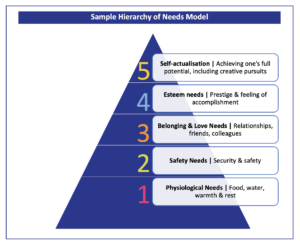
- Working from the bottom to top, our fundamental needs are ranked as: physiological, safety, love and belonging, esteem, and self-actualization. Maslow wrote about every person being capable of and having the desire to move up the hierarchy toward self-actualization.
- Put simply: Maslow suggested that humans must satisfy needs lower down the hierarchy before we can seek to meet needs higher up.
- Unfortunately, a person’s progress can be disrupted by a failure to meet lower level needs. Life experiences, including divorce, death and loss of a job, may cause an individual to fluctuate between levels of the hierarchy. Therefore, not everyone will move through the hierarchy in a uni-directional manner but may move back and forth between the different types of needs.
- Consider what has happened: COVID-19 has lead to the people you feed every day, your customers, experiencing several disruptions at once: public risk to health and safety (jeopardising safety needs), the death of a colleague, friend or family member and/or estrangement through self-isolation (threatening belongingness and love needs) as well as the loss of a job, even if temporary (challenging esteem needs).
- Remodelling your overall approach to foodservices, out of a response to the current pandemic is not a scatter gun approach. Using Maslow’s hierarchy of needs, caterers should look at what they do in terms of how they do it and why customers need them. More specifically: (a) why Client organisations will need to employ them, as they ramp businesses back up, and (b) why Customers will need to trust that they will be the safest pairs of hands to feed them, above others competing to feed them outside on the high street (delivered-in or otherwise).
PART C | The Experimental Approach: 7 TAF Lessons Learned (in the last 4 weeks)
- The British government have set in place fiscal and financial measures to help British business and people and, to our minds, are doing their best to meet our physiological needs – food, water, warmth and rest – and security needs (security and safety).
- Foodservices, contract caterers, facilities management companies, and organisations with in-house staff restaurants will have a responsibility to continue catering, as the economy picks up, but will need to address security needs for each and every employee, workforce member or your student population every day.
- With this said, on Tuesday 24th March 2020, as the COVID-19 pandemic started to unfold, TAF started to publish a series of Ten #TAFTalk Topics on LinkedIn intended as Thoughts for the Day.
- TAF presented cues to topical matters, that appeared (a) the most sought-after, talked about and sensitive matters on social media plus (b) important to those who fed back to us from within our own catering network.
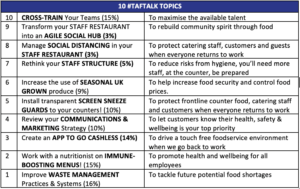
- The table (see right) presents our Ten #TAFTalk Posts ranked by popularity**; or percentage of the several hundred views, with those ranking as the most relevant, reliable and timely, bottom to top. The end column suggests which of Maslow’s needs are addressed.
- Consider this: look at your foodservice facilities now and ask yourself, do they meet the needs of the people you will feed every day, given the COVID-19 outbreak? More specifically, are your foodservices set up to address your customers’ security needs (security and safety) first, and then their need to belonging? The people you feed will be much happier and focused of self-actualisation the earlier you deal with the implications of the above.
- With renewed focus on the above areas to sharpen your proverbial axes – whether you’re in foodservices, contract catering, facilities, a restaurant or an organisation that self-manages an in-house staff restaurant – you’ll start to develop a coherent economic and psychological strategy. Your foodservices (in providing immune-boosting menus prepared by the safest industry hands, for example) will boost the performance of your client organisation which will, in turn, thrust the economy forward, as its business ramps, health and safety measures improve and human beings start having confidence in eating in the workplace because their needs are met by those who serve them every day!
** Waste Management, Immune-Boosting Menus, App To Go Cashless, Communications & Marketing, Screen Sneeze Guards, Seasonal UK Grown, Staff Restructure, Social Distancing Staff Restaurant, Agile Social Hub and Cross Train Your Teams.
SECTION 2 | A NEW 5-STEP APPROACH
With the above said, TAF propose those in foodservices ought to follow these 5 Steps to Success:
- Step 1 | Lead and Empower your TEAM through the Crisis
- Step 2 | Perform a SWOT Analysis
- Step 3 | Complete a BENCHMARK
- Step 4 | Redefine your USP
- Step 5 | Create Your EXIT STRATEGY
1 | Lead and Empower your TEAM through the Crisis
“Teamwork is the ability to work together toward a common vision. The ability to direct individual accomplishments toward organizational objectives.” | Andrew Carnegie
As a leader, how can you best support your team deal with and through a time of crisis? Here are five tips*4 to help people navigate change:
- Be Present | Let employees express emotion, let their voices matter and say how they really feel.
- Be Connected | Say you’re there for them, you’re in it together, you’ll move together, you’ll stand together.
- Explain Meaning Making | Ensure everyone understands the stories of their experiences, see below for this.
- Choose A Positive Future | Talk about how everyone would like to feel once the crisis is over.
- Forge A Path Together | Then you’ll know how to get where you want to go.
Our ability to navigate change corresponds to the meanings of the stories we make about what is happening, whether our experiences are positive, negative, empowering or devastating.
Consider this: Yes there may be lots of potential change to foodservices, post COVID-19: the high street may be hit hard, customers are likely to be price-sensitive, there won’t be an instant return to “normality”, currently there is only takeaway food available, all large gatherings are prohibited and the long term view (by some) is that there is no need to change the design of staff restaurants or foodservices. 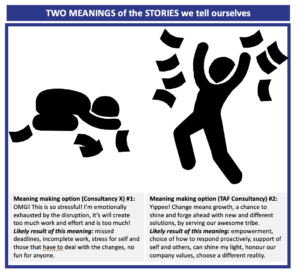
- Meaning making option #1: OMG! This is so stressful! I’m emotionally exhausted by the disruption, it will create too much work and effort and is all too much! | Likely result of this meaning: Stress for self and those having to deal with the changes, missed deadlines, incomplete work and no fun for anyone.
- Meaning making option #2: Yippee! Change means movement, growth and a chance to really shine and forge ahead with something new and different. I will show up fully to serve our awesome tribe. How great that I get to tap my awesome brain to become even clearer, find even more solutions as I focus on the outcomes I want to create as a result of an opportunity. | Likely result of this meaning: Empowerment, choice of how to respond proactively vs compulsively reactive, support of self and others, shine my light, honour our company values, choose a different reality.
2 | Perform a SWOT Analysis
WHAT is it? A strategic planning technique used to help an organisation identify strengths, weaknesses, opportunities and threats related to business planning.
WHY should you do one? A SWOT is critical when your business is trying to decide how to embark on a new venture or strategy. By clearly outlining all positives and negatives, your SWOT analysis makes it easier to decide how to move forward.
WHO should be responsible for your SWOT? The team you’ve empowered!
HOW should you create your SWOT Analysis? 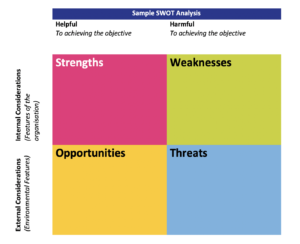
- Step 1 | Title | List the objective at the top. i.e. How will our foodservices in workplaces survive post COVID-19?
- Step 2 | Grid | Create a grid by drawing a large square and divide into four smaller ones.
- Step 3 | Label | Label strengths & weaknesses (as Internal Factors) + opportunities & threats (as External Factors).
- Step 4 | Colour | Colour each box, don’t worry about this too much now but psychologically*5 it will play its part if you follow this key: Strength = red | Weakness = white | Opportunity = yellow | Threat = blue
- Step 5 | Conclude | Analyze your completed SWOT.
IF the positive outcomes (i.e. strengths and opportunities) outweigh the negatives (i.e. weaknesses and threats), carry out the objective, as it is. If negative outcomes outweigh the positives, and this is important … make adjustments by thinking about how to convert threats and weaknesses into strengths or opportunities and relocate them in your chart (it’s really that simple)!
Ultimately, your SWOT analysis will take some effort to organize and it will require a collaborated effort from your on-site team, but the insights you’ll gain will be invaluable in the short, medium and long terms, as business levels ramp up.
3| Complete a BENCHMARK
WHAT is it? A strategic practice used for an organisation to see how it compares to others. The goal being to get an idea of where you are, where you want to go and start planning how you’ll get there.
Why should you do one? A BENCHMARK is critical as it compares your product, place, price, promotion and performance metrics to best practices from your competitors, so you or your restaurant can develop plans on how to improve or adapt performance to be more in line with, and better than, best practice.
WHO should be responsible for your BENCHMARK? Again, the team you’ve empowered. All parts of your business to establish what to include of importance (if you’re a contract caterer or you run your own restaurant).
HOW should you complete your BENCHMARK? 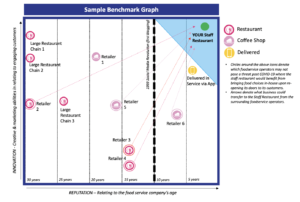
- Step 1 | Title | Determine the objective i.e. How will we evolve and innovate our foodservices in workplace X to survive post COVID-19?
- Step 2 | KPIs | List all the metrics where benchmarking would deliver the key insight for you (i.e. for example, all 10 of the areas featured in “TAF’s Experimental Approach”).
- Step 3 | Target | Competitors based on what you want to get out of the benchmark. For example, benchmark your closest competitors, within a one to ten-minute walk from your front door by comparing your average spend against what customers could spend with them. This will give you a good view of what you’re directly competing against.
- Step 4 | Tools | Choose your tools to help you to review your benchmark metrics. This is where TAF steps in for our client benchmarks and why we’re told repeatedly no one in our industry produces benchmarks like us.
- Step 5 | Compare | Benchmark competitors (against your metrics) and segment to suit (i.e. Restaurants, coffee shops and delivered)
What comes next is not as simple as just doing what the best do but using the valuable insight you’ve gained into how they operate and work (especially when it comes to labour, health and safety, moving forward). It provides insight into rebuilding your own foundations for future foodservices and your USP for your customers.
4| Redefine Your USP
WHAT is it? A USP is… a unique selling proposition or unique selling point. 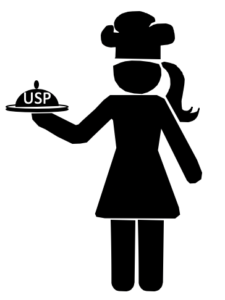
WHY should you create a new one? Your USP is what will make your staff restaurant, hospitality and/or foodservices different, stand out from the crowd and tell your customers what is special about you. It’s what you offer that no-one else does in your market – whether that’s safer environments for employees, workforce or students to have a coffee or lunch in post COVID-19, higher quality, lower prices, better customer experience or new technological innovations (such as an app).
WHO should be responsible for your new USP? Consumers are bombarded with messages every day. To make life easier, they organise products and services into groups and position them accordingly – for instance, the safest restaurant, the most expensive Latte and the best value meal deal. A strong selling proposition, well communicated, will help customers quickly understand what your foodservice offers and why they should choose you over heading to the high street outside.
HOW should you start the process of creating a new USP (post COVID-19)?
Finding your USP means understanding new COVID-19 target market, competition and industry.*6
- Step 1 | Understand your target audience | What do you know about them and why will they buy items from the market you operate in? What needs do those items meet for them? In other words, are they looking for a trustworthy supplier, safety first, immune-boosting nutritional expertise (post COVID-19) or something else? List all the reasons employees, workforce or students may choose you to buy from.
- Step 2 | Define your competitive advantage | List one or two things you believe your business is really good at. Refer to your competitor benchmark and see which needs they’re meeting and how well they meet those needs. Just because someone currently has a good position in a market doesn’t mean that they’ll deliver on their promises post COVID-19. If you can do better, that’s a strong basis for market entry.
- Step 3 | Establish industry trends | Look at those needs that aren’t being met by anyone, and think about the key trends in your industry – thus #TAFTalks. Consider trends that may mean legislative changes (re, social distancing) and new online “delivery” competition. Consider current trends and those issues that will be most important in five months’ time. Now see if you can extend your advantage into these areas.
Come up with a strong statement that conveys your USP, this should be your positioning statement defining: WHAT business you are in; WHO your target customers are; WHY they come to you (i.e. the single most compelling benefit you that sets you apart from the competition; and HOW you deliver on what you promise. Have a look at ours right here www.tafcateringconsultancy.com.
Your USP should drive the development of your business and your marketing strategy, whether you are creating a website or a logo, or embarking on a post COVID-19 marketing campaign. Always ask yourself if your image and activity clearly communicate the benefits you are offering your customers. It’s not advisable to change your unique selling proposition too often, but it is important to keep it fresh; thus the need to redefine your right NOW.
5| Create your EXIT STRATEGY
Why would you want to think about an exit strategy now, post COVID-19? After all, you’ve created am empowered team, have a SWOT analysis, completed a competitor BENCHMARK and redefined your USP; surely you’re going to be so successful and the future of your foodservices will be so much fun that you don’t need to think about what comes after?
Wrong. The best reason for an exit strategy is to plan how to optimize a good situation, rather than get out of a bad one. Don’t wait until the 5pm briefing to signal the green light and the restart of trading again to think about an exit, rather think of it as preparing a succession plan, or a successful mobilisation now. This allows you to run your business and refocus your efforts on things that make it more appealing and compelling.
An unexpected crisis, such as the COVID-19 crisis, could result in the failure of a previously successful foodservice or catering business. If you develop a good exit strategy ahead of time (i.e. now), you can ride the crisis in much better financial shape than you otherwise would.
Companies that rank among the eventual winners of riding a recession move deliberately to capture opportunities before a crisis or recession. While they focus intensively on cost transformation, they also look beyond cost.
 Think of the current crisis as a recession and a sharp curve on an F1 racetrack – the best place to pass competitors, but requiring more skill than straightaways. The best drivers apply the brakes just ahead of the curve (they take out excess costs), turn hard toward the apex of the curve (identify the short list of projects that will form the next business model), and accelerate hard out of the curve (spend and hire before markets have rebounded).
Think of the current crisis as a recession and a sharp curve on an F1 racetrack – the best place to pass competitors, but requiring more skill than straightaways. The best drivers apply the brakes just ahead of the curve (they take out excess costs), turn hard toward the apex of the curve (identify the short list of projects that will form the next business model), and accelerate hard out of the curve (spend and hire before markets have rebounded).
What specifically distinguishes eventual winners? Research*7 reveals several key moves by companies that outperformed peers, in four areas: early cost restructuring, plus some combination of balance sheet discipline, aggressive commercial growth plays and proactive M&A. Rather than go into any detail here, it’s probably more instructive for you to review each in more detail.
CLICK here to download a copy of the article as a separate Word document NOW: 150420_TAF_Whole_New_World_of_Foodservices_FINAL
TRACEY FAIRCLOUGH | Consultant & Managing Director
If you’re in Foodservices, Facilities, Foodservice Procurement or need advice on how to support a best practice approach to a whole new world of foodservices in 2020, to look at how to redesign your staff restaurant and virus-proof your foodservices post COVID-19 … Contact us TODAY at !
References:
*1. The 7 Ps www.freshbusinessthinking.com/the-7-ps-of-planning/
*2. Record fall in UK economy forecast www.bbc.co.uk/news/business-52232639
*3. Maslow’s Hierarchy of Needs https://www.simplypsychology.org/maslow.html
*4. Christine Comaford, Teamwork www.forbes.com/sites/christinecomaford/2016/10/02/how-to-lead-empower-your-team-through-a-crisis/#21a9928f6fd1
*5. Psychology of Colours www.psychologytoday.com/us/blog/people-places-and-things/201504/the-surprising-effect-color-your-mind-and-mood
*6. Amanda Walker www.marketingdonut.co.uk/marketing-strategy/branding/developing-your-usp-a-step-by-step-guide
*7. Research https://thecorner.eu/world-economy/well-prepared-firms-emerged-as-winners-during-after-past-recessions/84266/